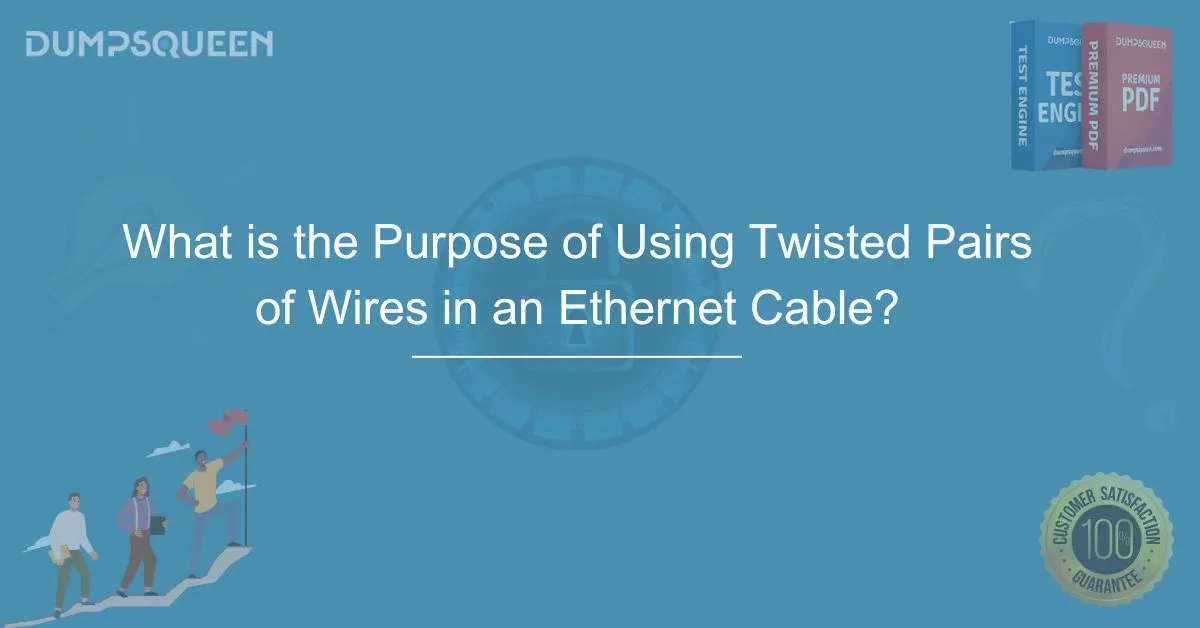Introduction
In the world of networking, Ethernet cables play a crucial role in ensuring seamless communication between devices. While various types of cables exist, twisted pair Ethernet cables remain the most commonly used due to their efficiency and reliability. But why are the wires inside these cables twisted? The purpose of using twisted pairs of wires in an Ethernet cable extends beyond just organization. This article, presented by DumpsQueen Official, delves into the significance of twisted pairs in Ethernet cables, explaining how they enhance network performance, reduce interference, and contribute to stable connectivity.
Understanding Twisted Pair Ethernet Cables
Twisted pair cables consist of multiple pairs of insulated copper wires, each twisted together in a specific pattern. This design is not random but rather a carefully engineered method to improve signal transmission. The twisting of wires helps counteract signal degradation caused by electromagnetic interference (EMI) and crosstalk. These cables come in different categories, including Cat5e, Cat6, Cat6a, and Cat7, each offering varying levels of performance.
How Twisted Pairs Reduce Electromagnetic Interference
Electromagnetic interference (EMI) occurs when external electronic devices, such as microwaves, power lines, and other networking cables, emit signals that disrupt data transmission. When electrical signals pass through a cable, they generate an electromagnetic field. If these signals are not properly managed, they can interfere with the signals in adjacent cables, leading to data loss and communication errors. Twisting the wires within an Ethernet cable helps neutralize these electromagnetic fields. The twists ensure that any interference affecting one wire is canceled out by the opposing interference in the adjacent wire, resulting in a more stable and reliable connection.
The Role of Twisted Pairs in Reducing Crosstalk
Crosstalk is another challenge in data transmission, occurring when signals from one wire pair interfere with signals from another pair within the same cable. This interference can lead to network slowdowns, data corruption, and communication errors. The twisting of wires significantly reduces crosstalk by balancing the electrical characteristics of the signal. This method ensures that unwanted signal coupling is minimized, allowing clear and accurate data transmission across the network.
Signal Integrity and Performance in Ethernet Cables
Maintaining signal integrity is critical in networking, especially in environments where data transmission must occur over long distances. Twisted pairs help maintain strong and consistent signals by reducing attenuation, which refers to the gradual loss of signal strength as data travels through the cable. The tighter the twists, the better the performance in preventing attenuation, ensuring that data remains intact from the source to the destination.
Cost-Effectiveness of Twisted Pair Cables
Twisted pair Ethernet cables are widely used not only for their technical advantages but also for their cost-effectiveness. Compared to other types of networking cables, such as fiber optics or coaxial cables, twisted pair cables are significantly more affordable while still providing reliable performance. Their flexibility and ease of installation make them a preferred choice for businesses, homes, and data centers looking for a budget-friendly yet efficient networking solution.
Noise Immunity and External Disturbances
Networking environments often contain various sources of noise, including power cables, fluorescent lights, and wireless signals, all of which can affect data transmission. Twisted pair cables provide enhanced noise immunity, ensuring that external disturbances do not compromise network performance. This is particularly beneficial in densely wired environments where multiple cables run close together. Shielded twisted pair (STP) cables further enhance noise resistance by incorporating additional protective layers to minimize signal disruptions.
Different Categories of Twisted Pair Ethernet Cables
Twisted pair Ethernet cables come in multiple categories, each offering unique performance benefits.
-
Category 5e (Cat5e): Supports speeds up to 1 Gbps and reduces crosstalk compared to standard Cat5 cables.
-
Category 6 (Cat6): Offers speeds up to 10 Gbps over short distances, with improved shielding against interference.
-
Category 6a (Cat6a): Provides enhanced performance over longer distances, maintaining stable high-speed connections.
-
Category 7 (Cat7) and Category 8 (Cat8): Designed for high-performance networking, offering superior shielding and higher data transfer rates.
Why Twisted Pair Cables Are Preferred Over Other Types
Ethernet networks require cables that ensure both reliability and efficiency. Twisted pair cables outperform other cable types in several aspects:
-
Compared to Coaxial Cables: Twisted pair cables are easier to install, more flexible, and offer better crosstalk resistance.
-
Compared to Fiber Optic Cables: While fiber optics provide higher speeds, twisted pair cables are more cost-effective for short- to medium-range networks and do not require specialized equipment for installation.
Conclusion
Twisted pairs of wires in Ethernet cables serve a crucial purpose in maintaining stable, interference-free data transmission. By minimizing electromagnetic interference, reducing crosstalk, and ensuring signal integrity, twisted pair cables provide a reliable and cost-effective networking solution. As technology advances, newer categories of twisted pair cables continue to improve, making them an indispensable part of wired networking. DumpsQueen Official recognizes the importance of understanding these networking fundamentals to ensure optimal performance in both home and business networks.
Free Sample Questions
1. What is the main advantage of twisting pairs of wires in an Ethernet cable?
A. To make the cable more durable
B. To reduce electromagnetic interference and crosstalk
C. To increase the weight of the cable
D. To simplify cable management
Answer: B. To reduce electromagnetic interference and crosstalk
2. How does crosstalk affect Ethernet cable performance?
A. It improves signal strength
B. It causes data corruption and network slowdowns
C. It reduces the cost of networking
D. It helps in better cable organization
Answer: B. It causes data corruption and network slowdowns
3. Which type of twisted pair cable offers the best protection against external interference?
A. Unshielded Twisted Pair (UTP)
B. Shielded Twisted Pair (STP)
C. Coaxial Cable
D. Fiber Optic Cable
Answer: B. Shielded Twisted Pair (STP)



